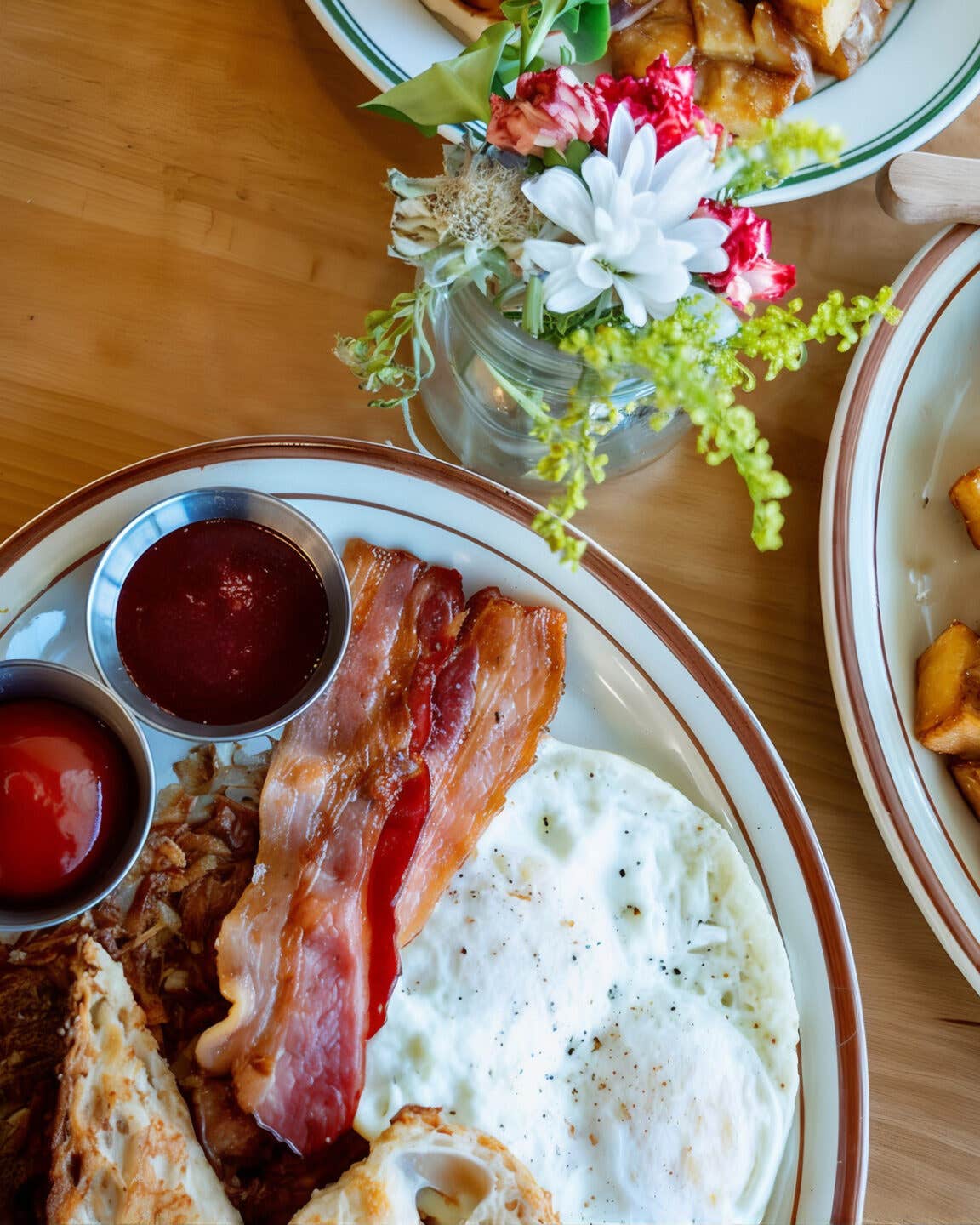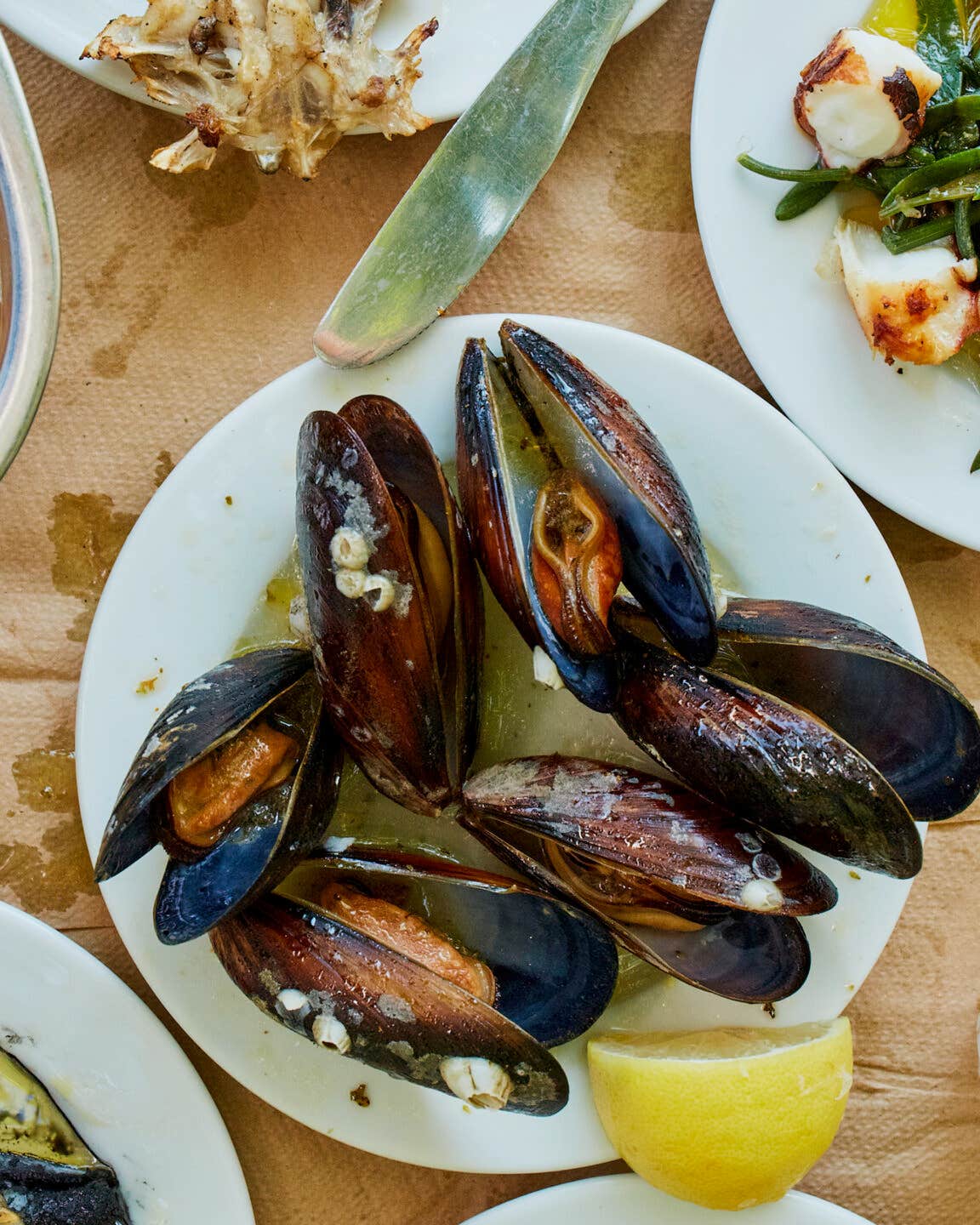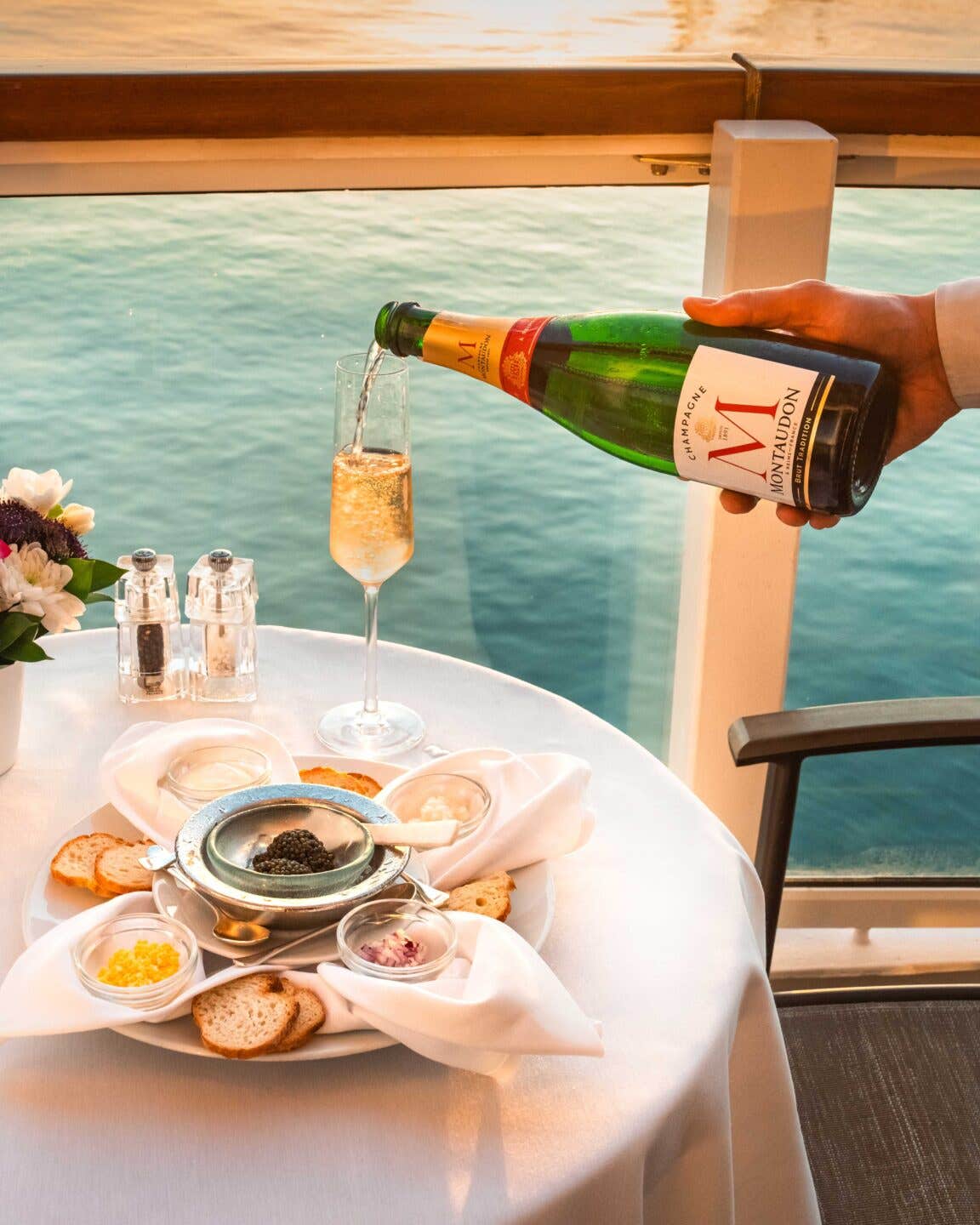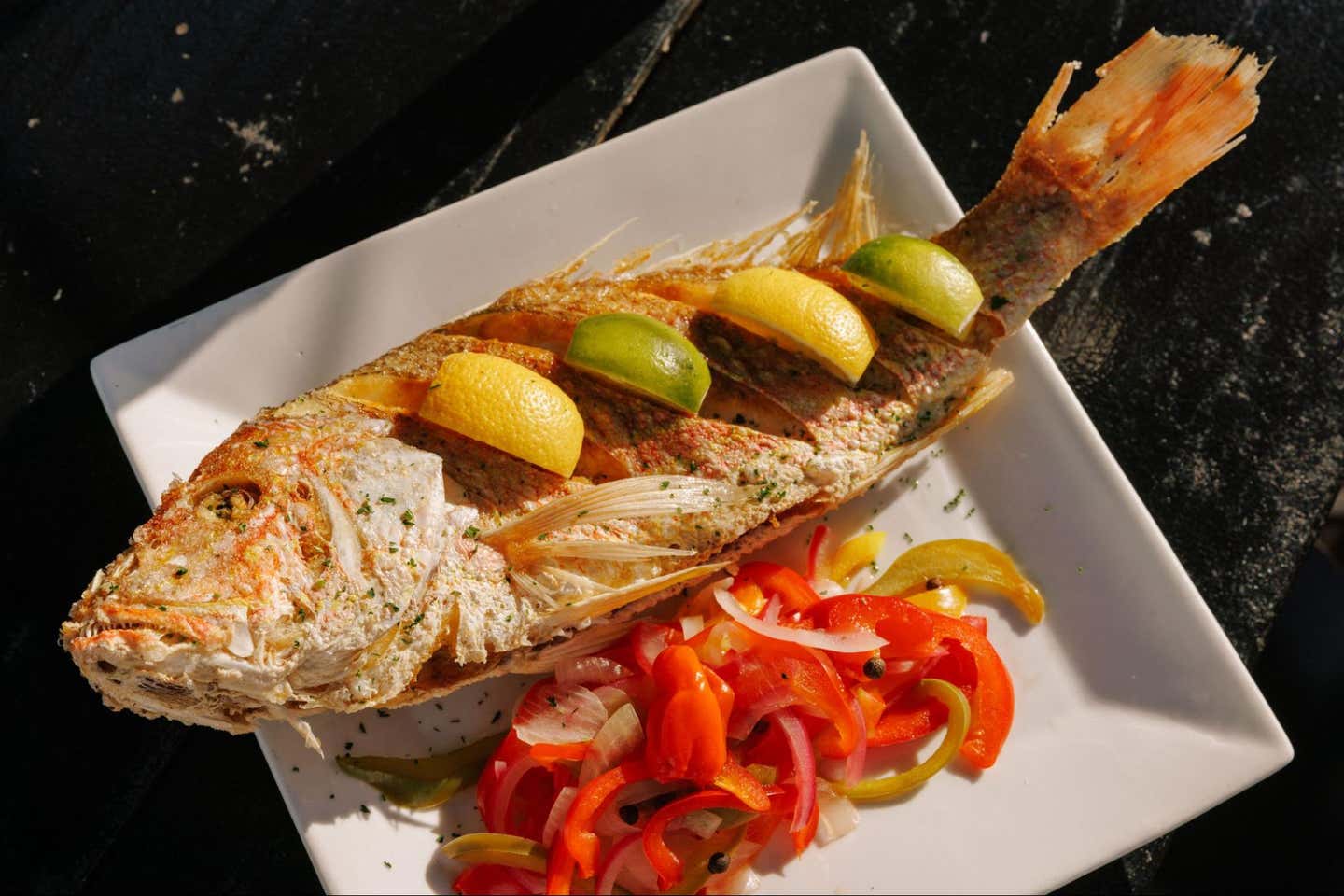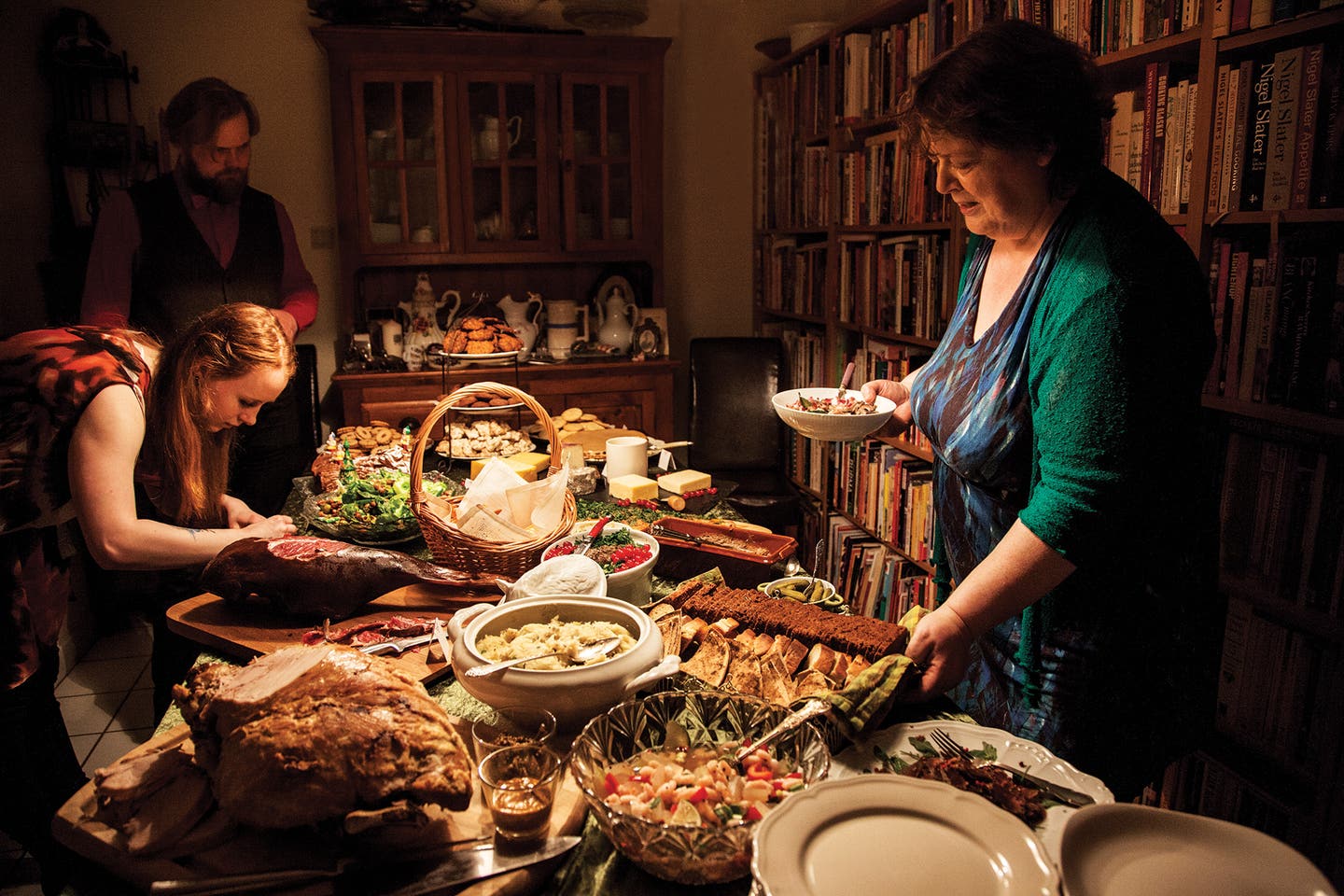
Northern Lights
Christmas in Iceland offers delicious food, wintry landscapes, and some much-needed cheer
It's three days before Christmas, and Nanna Rögnvaldardóttir is baking at a furious clip. A motherly woman with hazel eyes and a no-nonsense manner, she dollops out the glossy batter for marens-kornflexkökur, chewy meringues studded with dark chocolate and cornflakes, the pale peaks on the cookie sheet mirroring the snowcapped mountains outside. Then she starts in on kókosmjölskökur, small chocolate thumbprints laced with shredded coconut; oatmeal cookies with chocolate and pecans; and, finally, vínarterta, a cake of cardamom-scented shortbread layered with homemade prune filling. It's an Icelandic adaptation of an old Viennese classic; she'll ice it with a coffee glaze.
All the while, I'm trying to make myself very small so as to fit between Nanna's baking and her lifetime of cutlery and cooking vessels in this cozy galley kitchen in Reykjavík, Iceland. Two tawny legs of hangikjöt, smoked lamb, hang in a corner, partially displacing the willy-nilly array of cast-iron skillets. Out on the balcony in the chill air, a fresh ham floats with juniper berries, cloves, and bay leaves in a bin full of sienna-colored brine. The apartment is suffused with the aroma of sugary things slowly caramelizing in the oven. It's a smell that makes me happy, and right now I'm especially thankful for it.
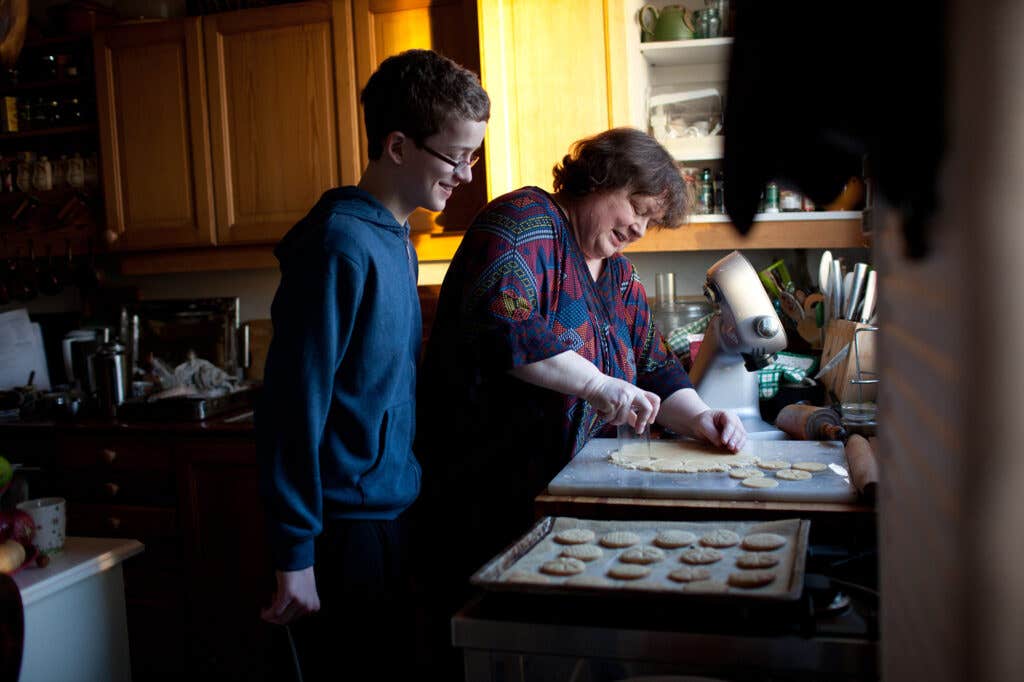
I'm here on this northern island in part because of Nanna's cook-book Icelandic Food & Cookery (Hippocrene Books, 2002). The volume, which I'd discovered months before on a shelf in New York, is loaded with Icelandic culinary history and classic recipes, many from Nanna's childhood on a remote farm. I was taken with the juxtaposition of the abundance in its pages and the intimation of cold, and of darkness. The island is so close to the Arctic Circle that at this time of year there are just four hours of daylight. Christmas fables here have an eerie edge. Instead of jolly Saint Nick and glowing-nosed reindeer, Icelanders have the 13 Yule Lads, trickster imps all, and a cat named Jólakötturinn who lurks in the gloaming, devouring naughty children on Christmas Eve.
These are grim legends from a far-flung place that was settled by wandering Vikings 12 centuries ago and, at 325,000 inhabitants, is still sparsely populated. Yet they are also tales of magic. Like the volcanoes that lie just beneath the island's surface, at the heart of Icelandic culture, there's heat. In spite of the near-eternal nights—or perhaps because of them—Christmastime is full of warmth and light. Icelanders, I'd heard, throw themselves into the holidays with a fierce joviality, lading tables with game and pristine seafood, earthy breads, and delectable desserts. I'm lucky that my fascination with Iceland has brought me here this year, because I'm craving these seasonal comforts more than usual. My husband of a dozen years and I have just called it quits, and I need some proof that light can outshine the darkness.
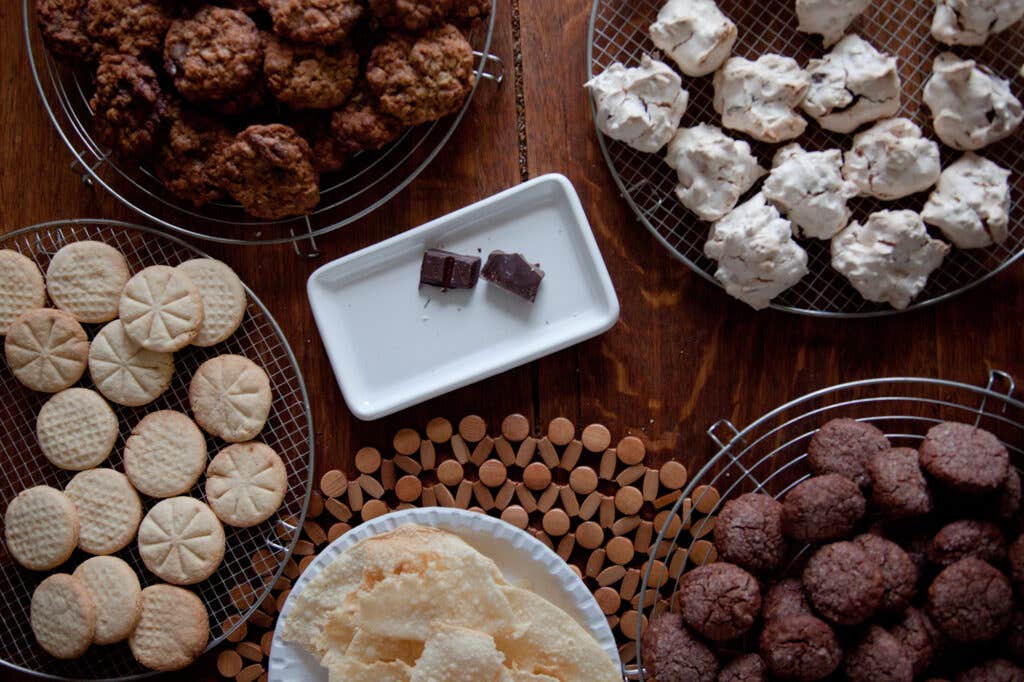
The doorbell buzzes and Nanna bustles out of the room, then back in again, her grandson Úlfur, 12, now in tow. Gold-rimmed glasses and short sandy hair frame a pale, serious face as he quietly surveys this American stranger in his grandmother's kitchen. He's just in time to help make laufabrauð, or leaf bread, a delicate flatbread that blisters and crisps when dropped in hot oil. As Nanna rolls dough and mans the fryer, Úlfur uses a leaf bread iron, a rolling stamp attached to a metal rod, to produce imaginative geometric designs: triangles, chevrons, herringbones, and crosshatches. "In the past, making leaf bread was the only time of the year the men of the family came into the kitchen to cook," Nanna tells me, proudly assessing his work. An array of beautifully decorated breads is soon fanned out across the counter. I sample a warm one. It shatters and then melts in my mouth, buttery and just this side of savory.
All this cooking, Nanna tells me, is in preparation for Þorláksmessa, which honors Saint Thorlak, Iceland's patron saint, on December 23. The holiday, a Catholic tradition that caught on with Iceland's Lutheran majority, is set aside for huge, festive luncheons at which skata, fermented skate, is served, to signal the end of the Christmas fast. The meal precedes the Christmas Eve feast, a moment of decadence in what historically was an austere life. It makes a sort of sense, I think: The bounty seems even more enjoyable when something rotten is eaten before it.
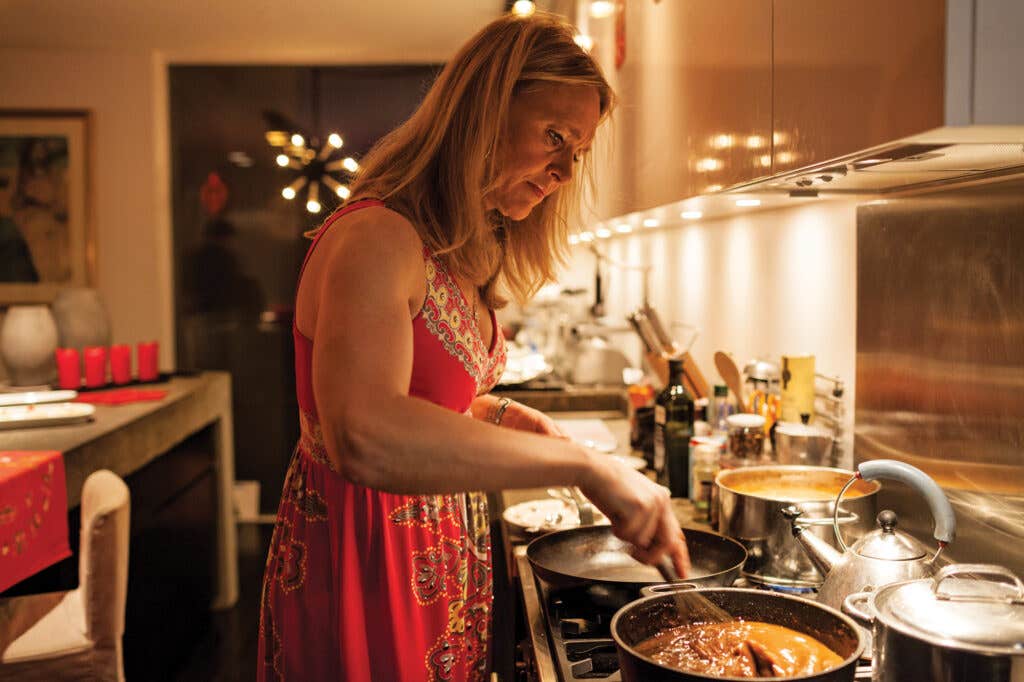
Still, I get Nanna's drift when she tells me that she herself can't stand the putrid fish. Her buffet features comfort foods instead—glazed ham and smoked lamb, pickled herring and homemade terrines, and the host of cookies and cakes she's been making. With the day wearing on, Nanna starts in on her last task, prepping the dense, sweet dark rye bread that she'll bake at a very low temperature overnight to mimic the traditional lava-pit method. The bread was once commonly baked in holes in the ground heated naturally by Iceland's copious geothermal steam.
"I was a very bad cook until I was about thirty," she tells me as she works. "About that time my husband and I divorced, and after that I didn't have to make everything like his mother. I became a better cook when I started doing things my own way." I think of my fractured family and wonder what my own future might bring.
On the following morning, for my first Saint Thorlak's party of the day, I arrive at the home of Kjartan Ólafsson and Kaja Gunnarsdóttir, a couple I met in New York a few weeks back. Kjartan, a seafood retailer and former critic for the Icelandic food magazine Gestgjafinn, throws a massive skata luncheon every year. Forewarned, I've donned my most dispensable clothes, stowing a spare outfit to change into afterward. Kjartan and Kaja greet me at the door, he dressed in white and she in red, complete with matching high-top Converse sneakers, a modern-day Mr. and Mrs. Claus. Kaja, a vivacious brunette, kisses me on each cheek and leads me toward the kitchen. But I stop short at the threshold, my eyes tearing up from the ammonia fumes coming from the boiling skata. Kjartan laughs and cracks open a window. In addition to the skate, there are cod fillets baking in the oven. Boiled new potatoes, a simple salad, and rye bread with butter round out the menu.
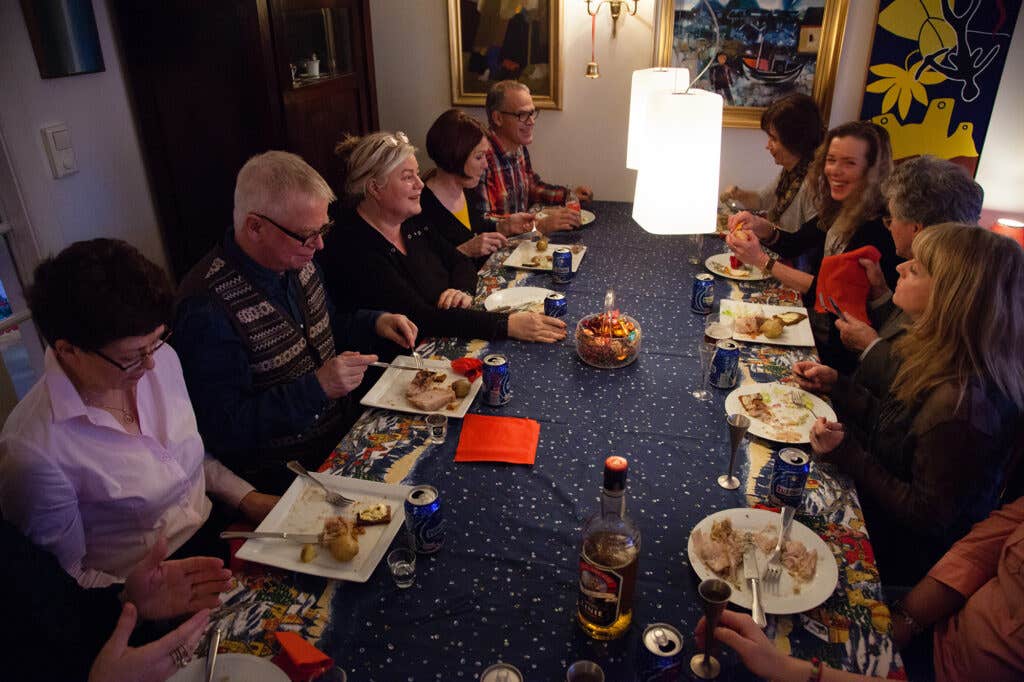
Kaja pours us each a brennivín, the local aquavit. We clink glasses, utter "Skál!" and down our drinks, the caraway-flavored distillate heating my throat. Guests begin pouring into the kitchen, and Kjartan and Kaja dole out the skate. I douse mine with melted mutton fat as instructed, and then take a small bite. It's not as bad as it smells, but I won't be a skata convert after all. Instead I load up on cod, spooning an unctuous sauce of butter and chopped boiled eggs over the top. Before I know it, it's time to head to Nanna's. I change clothes in the driver's seat of my rental car.
Nanna's apartment is crammed with people circling a massive spread. Cookies and the vínarterta crowd the far end of the large table. The ham takes the place of honor at the head, orbited by a reindeer terrine, pâtés of chicken liver and smoked mackerel, and the smoked lamb, shavings of which will top buttered dark rye bread. There is also home-pickled herring, citrus-glazed salmon, cured goose breast, salted beef tongue, a mash of salt cod, and an assortment of cheeses. I fill a plate. All around me friends and family chatter and laugh.
As I finish the last bite, I realize I haven't seen Nanna yet. Finding her where she always is, in her kitchen, I want to ask her about her husband, whether she ever misses him. But I can't say the words aloud, and it's too cheerful an occasion for such conversation. So I offer instead to help clean the kitchen, even though I know that she will refuse.
The next day is Christmas Eve. Kaja and Kjartan are heading to Kaja's sister Þorgerður Gunnarsdóttir's house to celebrate. Kjartan has said apologetically that they would welcome me to the meal, but they don't want to upset the older generation by altering the long-standing custom of including only family for this most intimate of gatherings. I understand. I was raised in a Scandinavian sect of Evangelical Lutherans; this clannish exclusivity is reminiscent of our own holidays growing up. I have accepted their invitation to come over beforehand, though, to peek in on the cooking.
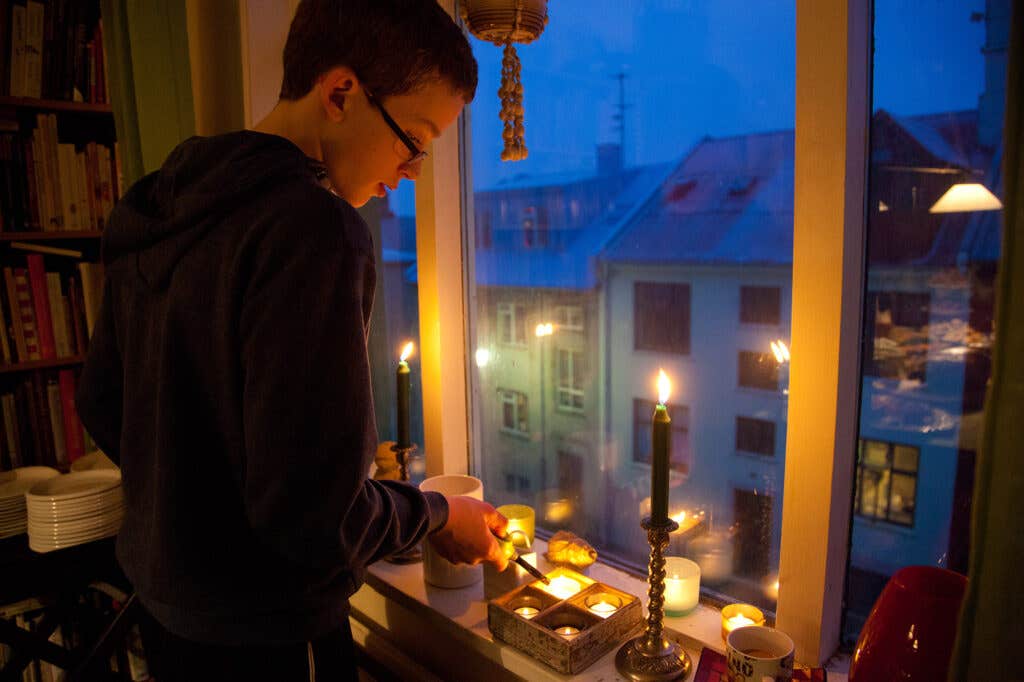
When I arrive, Þorgerður is breaking down the carcasses of small birds. They turn out to be ptarmigan, a wild Icelandic grouse. She makes a sauce from the wings and legs, flavored with thyme and bilberries, to accompany the seared and thinly sliced breast meat. When it's done, I snap up a piece, mopping up the sauce, savoring the ferrous quality of the meat, which is tempered by a subtle spiciness from the grouse's diet. Langoustine soup simmers on a back burner. Þorgerður ladles me a portion, topping it with tender tail meat, whipped cream, and minced chives. The rich crustacean stock is bolstered with cream and curry powder.
As evening descends, the family changes into their holiday best. The sisters' parents arrive, and I take this as my cue to exit. As I pull on my coat, Kjartan invites me to join them for Christmas mass the next day. Like much of Iceland's population, he is Lutheran, but Kaja's family is Catholic. Though I haven't been to church in many years, I agree to meet them.
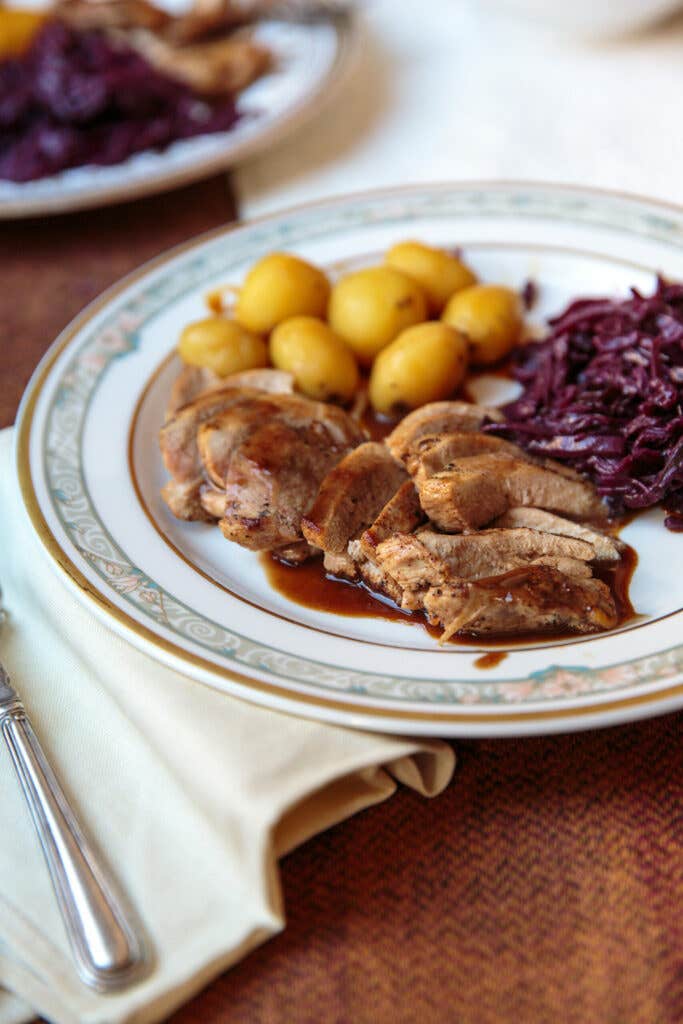
I head back to my hotel, where I've made a reservation for my own Christmas Eve dinner, along with the other travelers unrooted for the night. Afterward, I reach out with holiday greetings to my family. It's almost midnight when I call my grandmother in California; it's the eve of her 98th birthday. She's happy to hear from me, and I tell her I'm in Iceland.
"Well, if that doesn't beat all," she responds in her unflappable Midwestern manner. "Is Jay with you?" I realize with a sinking feeling in my gut that she doesn't know the news.
"Grandma, there's something I need to tell you," I begin.
I walk to the church in darkness on Christmas morning. Kaja and Kjartan meet me on the front steps along with Gunnar, Kaja's father, and we enter together. The priest's homily begins in English, and then flows into Icelandic interspersed with Latin. As the geometric panes of stained glass windows begin to glow, saturated with light from the rising sun, I let the known and unknown languages wash over me.
After the service everyone congregates in the fellowship hall for coffee. As we finish our cups and get up to go, Gunnar lags behind. Though I've known this kind man only a few days, I feel a sense of camaraderie between us. He has welcomed me, like the others have, into his circle, inviting me to share in his faith and traditions. I turn to him with a "Gleðileg jól," merry Christmas, and kiss him on both cheeks. He reaches out and cradles my cheek with one hand. He presses his other thumb between my brows, sweeping it almost, but not quite, in the sign of the cross. His voice rings with compassion as he tells me, "Now your sight will be clear. Now your mind will be clear." Somehow Gunnar has seen through my visitor's careful manners to my sadness, which is softened now with the warmth that my new friends have shown me. I thank him. Then we walk through the door together to join the others.
Keep Reading
Continue to Next Story






